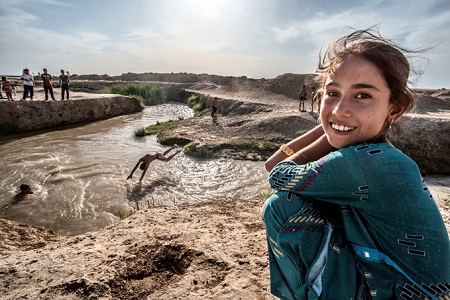State of World Population Report 2016:
What challenges do Georgian girls face?


Today the United Nations Population Fund (UNFPA) released its State of World Population Report 2016 that addresses the challenges facing young females worldwide, with a focus on 10-year-old girls.
Early marriage, teenage pregnancy and other manifestations of deep-rooted gender inequalities undermine girls’ health and rights and threaten the world’s ambitious development agenda,” warned the report.
The report and its Eastern Europe and Central Asia supplement discussed the problems 10-year-old girls faced worldwide and in 19 countries of the region, including Georgia.
The regional supplement said many girls in that age bracket "are held back by social and cultural norms and discriminatory laws and practices” preventing them to develop themselves and achieve future success.

"At age 10, a girl in our region is at a crossroads,” UNFPA Regional Director Alanna Armitage says. Photo by United Nation's Population Fund.
Key facts and figures for Eastern Europe and Central Asia:
- Most 10-year-old girls attend school in this region (but this is not the case for all population groups; for example more than 30 percent of young Roma are without even primary education in some countries).
- Child marriage is common in parts of the region, including southeastern Europe, the South Caucasus and Central Asia, but since the practice is generally illegal, there are few reliable figures.
- Teenage pregnancy is on the decline in the region but still three times more common than in Western Europe (and up to six times more common in some countries).
- Far fewer girls are born than boys in some countries and this is due to gender-biased sex selection; the region has some of the world’s largest sex-ratio-at-birth imbalances.
- Fewer women than men are in the workforce in all countries of the region.
- Adolescent girls are particularly vulnerable in humanitarian crisis situations but their needs and vulnerabilities are often overlooked.
The report said in Eastern Europe and Central Asia girls were generally well-educated and later even surpassed boys and young men in higher education but factors like early marriage, pregnancy and difficulties to combine work and child-rising, disturbed their active role in public.

A 10-year-old Georgian girl speaks to UNFPA. Photo by United Nations Population Fund.
In Azerbaijan and Georgia, the countries in the region most affected by adolescent pregnancy, the teenage fertility rate is about six times higher,” the report said.
The report stressed far fewer women than men were in formal employment in all countries of the region.
When it came to Georgia nearly 60 percent of women and more than 80 percent of men were employed.
The report also mentioned the harmful practice of gender biased sex selection in regional countries.
The 2014 UNFPA report said if a family chose to have one child in Georgia, 46 percent of the citizens preferred the child to be a boy, 45 percent said the gender of the baby was unimportant while just nine percent wished to have a baby girl.
The calculations established that due to such practices about 25,000 girls had not been born in Georgia from 1990 to 2010. If such tendency persists, the figure will reach 80,000 by 2050,” the previous report stressed.

The report said in Eastern Europe and Central Asia girls were generally well-educated and later even surpass boys and young men in higher education but their chances to develop themselves decreased. Photo by UNFPA Georgia.
Report recommendations to address the current problems included:
- Investments must go beyond formal schooling, as early childhood experiences greatly affect social outcomes. This includes policies allowing parents to balance work and family.
- As quality school-based sexuality education rarely exists in the region, introducing such programs in schools across the region, along with youth-friendly services, is one important way of empowering teenagers to make informed choices and avoid unintended pregnancies. And where teenage pregnancy is the result of child marriage, stronger measures to combat this harmful practice must be put in place.
- Investing in the education and employment opportunities of girls and young women, and making affordable childcare available.
- Far greater engagement in challenging people’s attitudes about child marriage and, more broadly, the status of women and girls.
- Work-life policies should ensure that parental leave can be shared, and is taken up, by both parents, and that people have access to affordable quality childcare.
- Empowering the current generation of young people to invest in their own children.
- Decisive steps need to be taken to combat ingrained gender inequalities and discrimination. This includes school education programs, awareness-raising campaigns and empowering women at work and in public life and similar.
 Tweet
Tweet  Share
Share